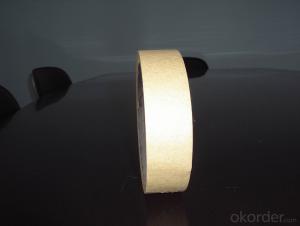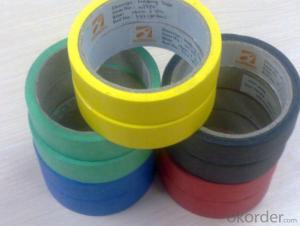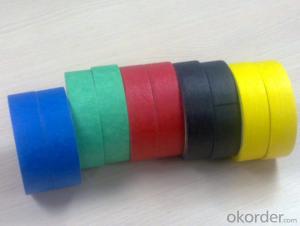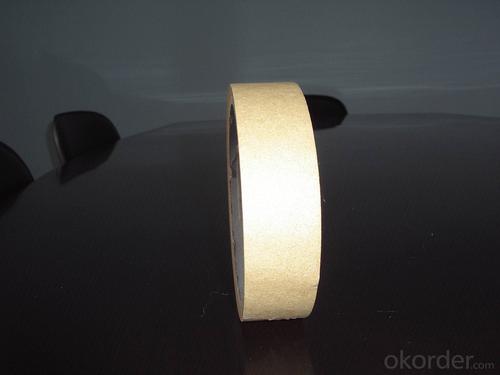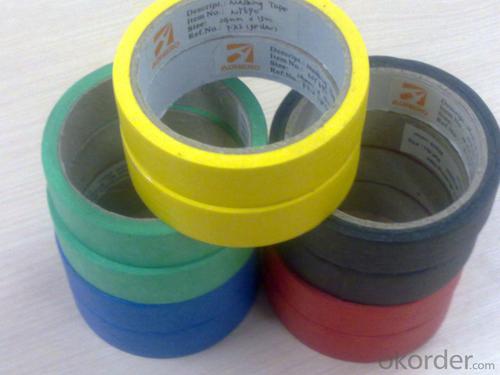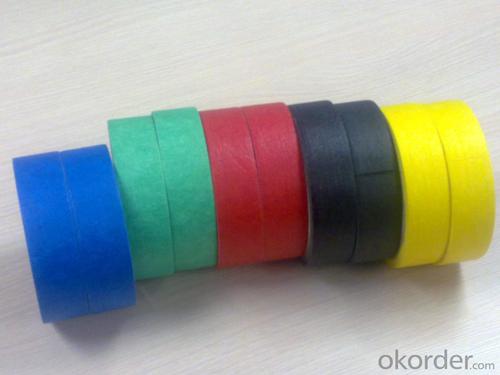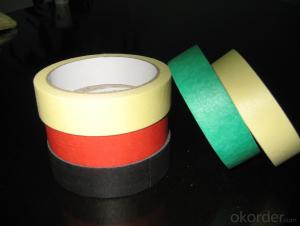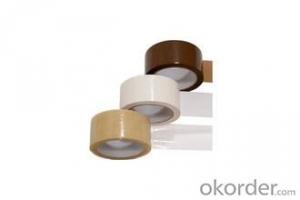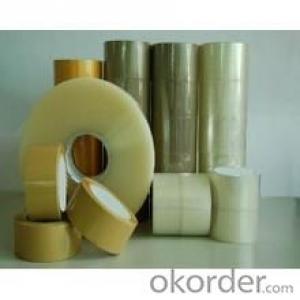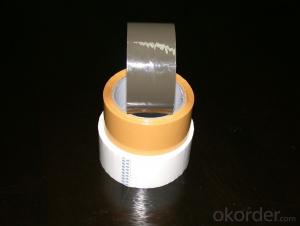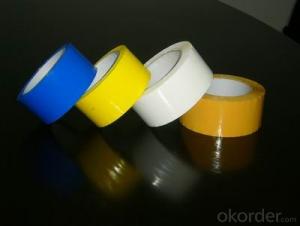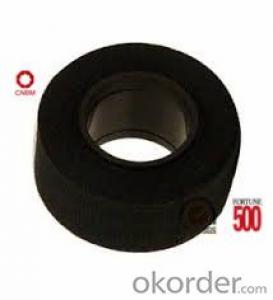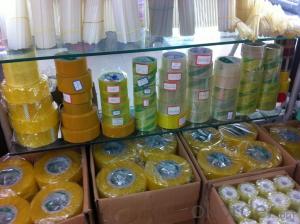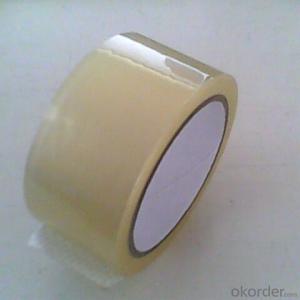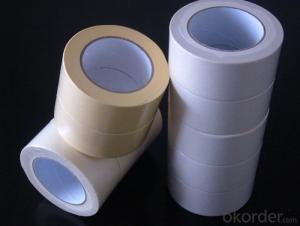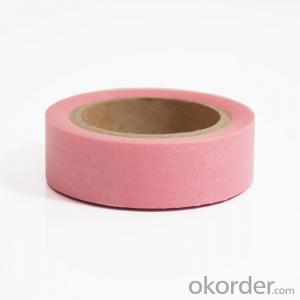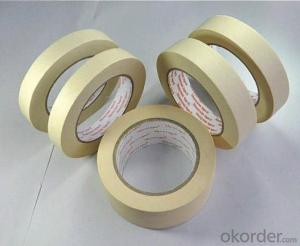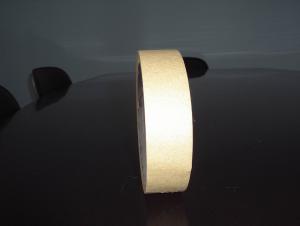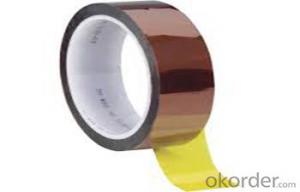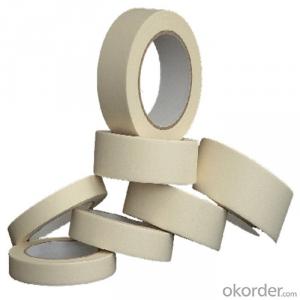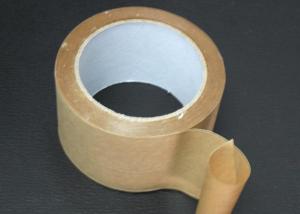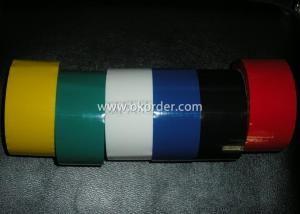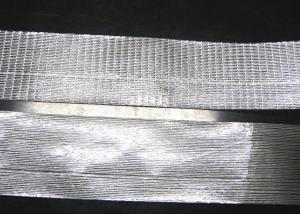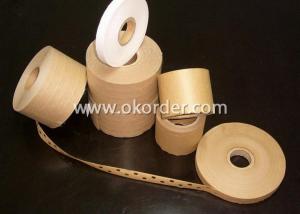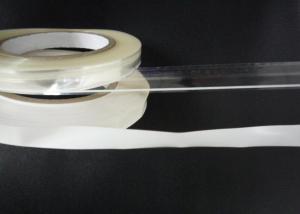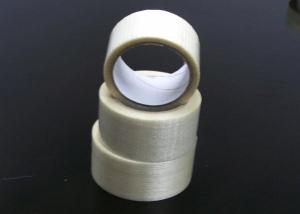Customised High-Quality Masking Tape for General Packing in India
- Loading Port:
- Fuzhou
- Payment Terms:
- TT OR LC
- Min Order Qty:
- 500 roll
- Supply Capability:
- 20000 roll/month
OKorder Service Pledge
OKorder Financial Service
You Might Also Like
Introduction of Masking Tape
Masking tapes are made of paper coated with acrylic adhesive or rubber based adhesive.
Application of Masking Tape
Interior paint masking, silk screening, Light duty packaging, bundling, holding, splicing &Tabbing, and other non-critical applications where a pressure-sensitive tape is needed.
Advantage of Masking Tape
1.Masking tape, superb tack and adhesion to surface, Strong grip that is ensured because of an excellent adhesive backing.
2. Peak performance even under extreme conditions of pressure and temperature, which can stick to all types of surfaces.
3. Consistent quality
4. on time delivery
5. Effective and timely communication
6. Competitive price
Packing of Masking Tape
Jumbo rolls & log rolls: Packed with kraft paper and stretch wrap film, with or without pallet
Cut rolls: Shrink package, placed in cartons, with or without pallet
Jumbo rolls & log rolls: Packed with kraft paper and stretch wrap film, with or without pallet
Size of Masking Tape
Paper Core ID: 76mm
Jumbo size: 0.99m x 1800m, 1.22m x 1800m, 1.51m x 1800m
Cut roll size: As per customer's requirement
Cut rolls: Shrink package, placed in cartons, with or without pallet
Pictures of Masking Tape
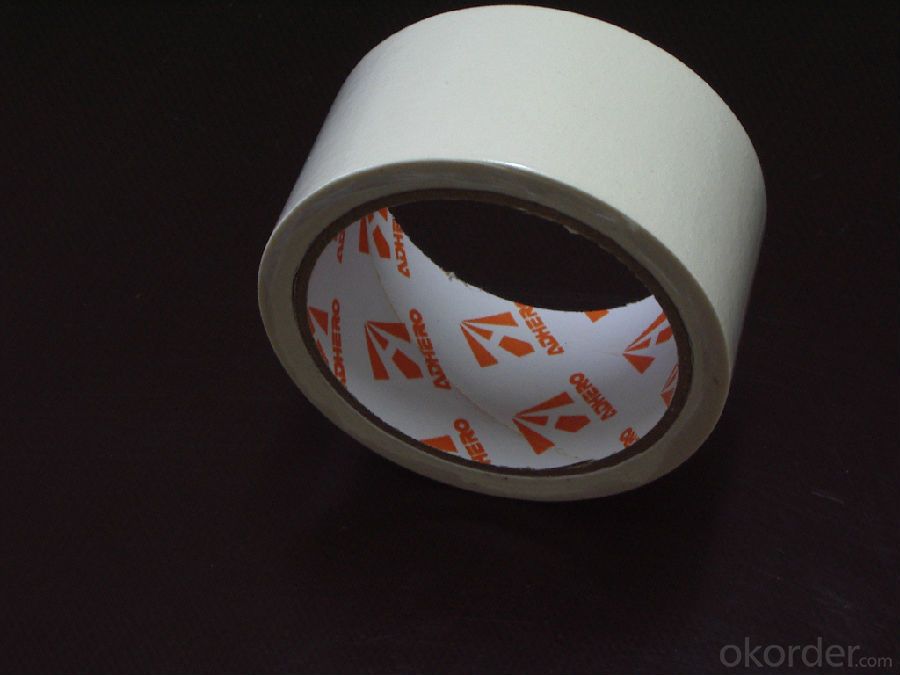
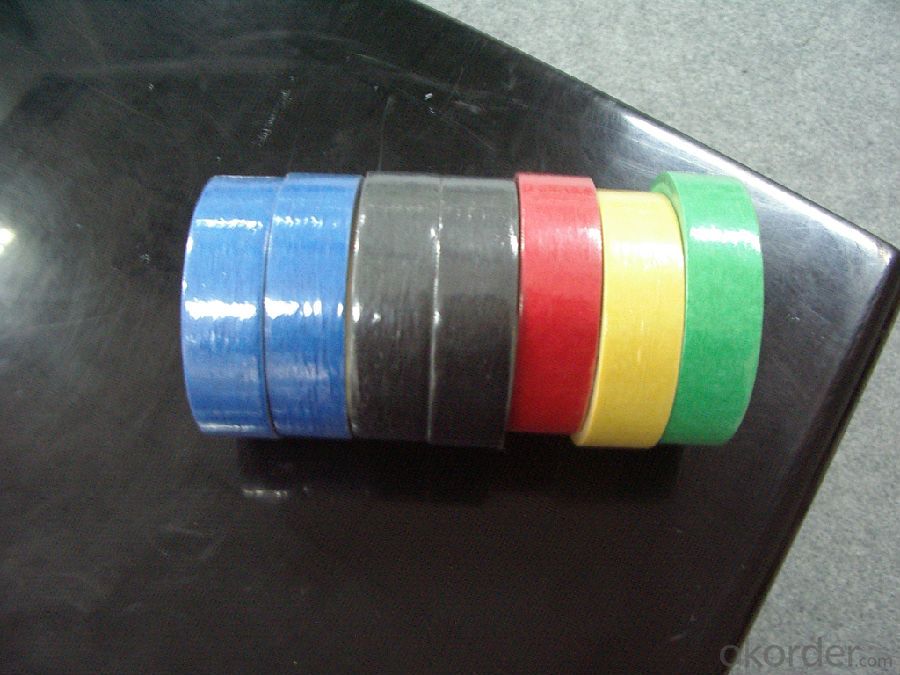
Specification of Masking Tape
| Material | Masking tape |
| Adhesive Side | Single Sided. |
| Adhesive | Rubber based acrylic adhesive |
| Acrylic | Rubber |
| Color | White/yellow/black/orange /brown/blue/red/ green |
| Normal thickness | 150mic, 160mic, 170mic, 180mic, 190mic, 200mic |
| Packaging | Single packed, shrink film packed, depend on customer’s request |
Remarks:
1. The data above are typical results and subject to change without notice.
2. Tolerance: Weight and Thickness: ±10%; Width: ±3mm;
Length: Cut Roll & Log Roll ±0.3m, Jumbo Roll ±0.5%.
3. The products should be stored at room temperature and kept from wet and heat source.
4. It is essential, as with all pressure-sensitive tapes, that the surface to which the tape is applied must be clean, dry, and free of grease and oil.
5. The user should take test and do trial-application on the above products before coming into application so as to witness and ensure suitability for user’s special purpose and technique.
FAQ
1. What is the range of your products?
So far, we manufacture various kinds of double sided adhesive tape, masking tape, kraft tape and BOPP packing tape. To better meet your needs, we can also source other adhesive tapes for you if it is appropriate to do so.
2. What's the lead time for delivery?
We ensure you a prompt delivery of the goods. We do not stock any of the goods. The production cycle time of 1*20FCL is 2-3 weeks.
3. How many carriers does your double sided adhesive tapes have?
There are many carriers that our double sided adhesive tapes based on, which are tissue, PET, BOPP, PE foam, EVA foam.
4.Can you accept the cooperation way of OEM?
Upon receipt of formal authorization, we can accept OEM processing.
- Q: Can scotch tape wrap wires?
- No, it's not safe. We should use electrical tape. We have a lot of transparent tapes for the last time
- Q: How does packaging tape perform on high-friction surfaces?
- Packaging tape is designed to adhere to a wide variety of surfaces, including high-friction surfaces. Its performance on high-friction surfaces can vary depending on the specific tape and the nature of the surface. In general, packaging tape is equipped with strong adhesive properties that allow it to stick securely to surfaces, even those with high friction. The adhesive on the tape is formulated to provide excellent tackiness and bonding strength, ensuring that it stays in place and maintains its hold on high-friction surfaces. However, it is important to note that excessive friction or roughness on a surface can potentially affect the tape's adhesion. If the surface is extremely rough or uneven, it may create air pockets or gaps between the tape and the surface, which can compromise its performance. In such cases, it is advisable to prepare the surface properly by cleaning and smoothing it before applying the tape to ensure optimal adhesion. Additionally, the durability of the tape can play a role in its performance on high-friction surfaces. Some packaging tapes are reinforced with fibers or have a thicker construction, making them more resistant to wear and tear caused by friction. These tapes are often recommended for heavy-duty applications or when packaging items that will be subjected to constant rubbing or sliding on high-friction surfaces. Overall, packaging tape is generally well-suited for use on high-friction surfaces. Its adhesive properties, combined with proper surface preparation and selection of a suitable tape, can ensure reliable and long-lasting adhesion, even in challenging conditions.
- Q: How do I prevent packaging tape from curling up?
- To prevent packaging tape from curling up, there are a few things you can try: 1. Use a tape dispenser: Using a tape dispenser helps keep the tape straight and prevents it from curling. It also makes it easier to cut the tape to the desired length. 2. Apply tape evenly: When applying the tape, make sure to pull it tightly and apply it evenly across the surface. Avoid any wrinkles or bubbles as they can cause the tape to curl up. 3. Clean the surface: Ensure that the surface where you are applying the tape is clean and free from any dust, dirt, or moisture. These factors can interfere with the adhesive properties of the tape, causing it to curl. 4. Store tape properly: Proper storage of packaging tape is essential to prevent it from curling. Keep it in a cool, dry place away from direct sunlight. Extreme temperature changes can affect the tape's adhesive properties and lead to curling. 5. Choose good quality tape: Invest in high-quality packaging tape that is designed for long-term adhesion. Cheaper tapes often have lower quality adhesives that are prone to curling. 6. Use a heat source: If you are experiencing curling issues with the tape, you can try using a heat source like a hairdryer on a low setting. Gently heat the tape while applying it to help activate the adhesive and reduce curling. By following these tips, you should be able to prevent packaging tape from curling up and ensure a secure and professional-looking packaging.
- Q: What are the considerations for using packaging tape on corrugated cardboard boxes?
- When using packaging tape on corrugated cardboard boxes, it is important to consider the strength and durability of the tape, as well as its adhesive properties. The tape should be strong enough to securely seal the box and withstand any potential stress or weight during handling and transportation. Additionally, the tape's adhesive should be able to adhere well to the corrugated surface and provide a tight seal, preventing any contents from shifting or falling out. It is also advisable to choose a tape that is easy to apply and tear, ensuring efficient packaging processes.
- Q: Can packaging tape be used for sealing bubble wrap?
- Yes, packaging tape can be used for sealing bubble wrap.
- Q: Is packaging tape resistant to oil or grease?
- Yes, packaging tape is generally resistant to oil or grease. Packaging tapes are designed to securely seal boxes and packages, ensuring that the contents inside are protected during transportation. These tapes are typically made of materials such as polypropylene or PVC, which have properties that make them resistant to various substances including oil and grease. This resistance helps to prevent the tape from deteriorating or losing its adhesion when it comes into contact with oils or greases commonly found in industrial or commercial settings. However, it is important to note that the level of resistance may vary depending on the specific type and quality of packaging tape used.
- Q: What are the considerations for using packaging tape on wooden surfaces?
- There are several factors to consider when using packaging tape on wooden surfaces. Firstly, it is crucial to select the appropriate type of tape for the wood. Choose a tape specifically designed for wood or one with a gentle adhesive to prevent damage or residue. Avoid strong adhesive or duct tapes that may leave sticky residue or peel off the wood's finish. Secondly, take into account the condition of the wood. If it is old, fragile, or has cracks, extra precautions are necessary. Applying tape directly to damaged or delicate wood can cause further harm, such as stripping the varnish or causing splintering. In such cases, alternative methods should be used to secure or protect the wood. Consider the duration for which the tape will be applied. If it is temporary, most types of packaging tape are generally safe to use. However, if the tape will be left on the wood for an extended period, choose a tape that is less likely to damage or leave residue when removed. Additionally, be mindful of the climate or environment in which the wood will be situated. Extreme temperatures or humidity can affect the adhesive properties of the tape, potentially causing it to lose stickiness or damage the wood. In such cases, alternative methods may be required to secure or protect the wood. Lastly, always test a small, inconspicuous area of the wood with the tape before applying it extensively. This allows for assessment of any potential damage or residue and helps make an informed decision about using the tape on the entire wood surface. By considering these factors, one can ensure the safe use of packaging tape on wooden surfaces without causing unnecessary damage or issues.
- Q: Can packaging tape be used for sealing cardboard boxes?
- Yes, packaging tape is commonly used for sealing cardboard boxes as it provides a strong and secure bond.
- Q: Can packaging tape be used for sealing plastic storage baskets?
- Packaging tape possesses the ability to seal plastic storage baskets. Its strength and adhesive properties render it suitable for securing and sealing diverse materials, encompassing plastic. By implementing packaging tape, one can proficiently seal the openings or seams of plastic storage baskets, thereby ensuring the safeguarding and preservation of the contents. Nevertheless, it is imperative to acknowledge that the seal's durability and efficiency may hinge upon the quality and resilience of the particular packaging tape employed. Furthermore, it is advisable to cleanse and dry the surface of the plastic storage baskets before applying the tape to guarantee adequate adhesion.
- Q: How does packaging tape compare to duct tape in terms of strength and durability?
- Packaging tape and duct tape display notable disparities in terms of strength and durability. Packaging tape primarily serves the purpose of sealing boxes and securing lightweight packages, rendering it appropriate for general household use or tasks that involve low levels of exertion. It typically possesses a lower tensile strength and may be more susceptible to tearing or breaking when exposed to substantial stress or weight. Conversely, duct tape possesses a well-established reputation for its remarkable strength and durability. It is precisely engineered to provide a sturdy and long-lasting grip, making it the preferred choice for demanding tasks and repairs requiring a robust adhesive. Duct tape is composed of a resilient woven fabric backing coated with a durable adhesive, resulting in a tape capable of enduring high levels of tension and resisting tearing or breaking even in extreme conditions. While packaging tape is designed for temporary applications, duct tape is commonly employed in more strenuous and enduring projects, such as mending or fortifying items, bundling heavy objects, or even constructing provisional structures. Its versatility and superior strength make it a dependable option in situations where durability and resilience are of paramount importance. To summarize, packaging tape and duct tape diverge in their intended uses and capabilities. Packaging tape is suitable for lightweight applications and the sealing of boxes, whereas duct tape excels in heavy-duty tasks and offers outstanding strength and durability.
Send your message to us
Customised High-Quality Masking Tape for General Packing in India
- Loading Port:
- Fuzhou
- Payment Terms:
- TT OR LC
- Min Order Qty:
- 500 roll
- Supply Capability:
- 20000 roll/month
OKorder Service Pledge
OKorder Financial Service
Similar products
Hot products
Hot Searches
